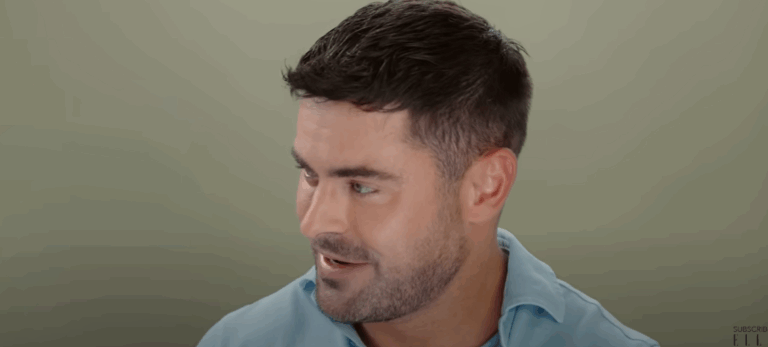Once boyish and subtly angular, Zac Efron’s face now represents a new chapter, one characterized by survival and unwavering physical stamina rather than vanity. Efron had a severe accident at home in 2013. He lost consciousness after slipping close to a granite fountain, falling face-first, and breaking his jaw. In addition to being physical, the fallout was also personal, professional, and, years later, mistakenly perceived as cosmetic.
Efron’s jaw was wired shut during his recuperation, and urgent reconstructive surgery was necessary to fix the damage. His entire lower face was adjusting to compensate, though, not just the bones and skin. The actor subsequently clarified that the injury and physical therapy caused his masseter muscles—which are involved in chewing—to become “exceptionally overdeveloped.” His jawline widened in a way that appeared to be a purposeful enhancement due to that muscular reaction.
The internet had already drawn its own conclusions by the time Efron made a public reappearance with this altered look. Speculation videos on TikTok received millions of views. With remarkable accuracy, Reddit threads analyzed both recent and old images. YouTube surgeons used red circles and freeze frames to examine his cheekbones. However, Efron addressed the noise head-on in a 2022 interview with Men’s Health, stating that he had not had plastic surgery. Because his face had to adjust and because he almost died, it had changed.
Zac Efron – Key Facts and Background
| Category | Details |
|---|---|
| Full Name | Zachary David Alexander Efron |
| Date of Birth | October 18, 1987 |
| Profession | Actor, Singer |
| Notable Works | High School Musical, Neighbors, The Greatest Showman, Iron Claw |
| Injury Date | 2013 |
| Type of Injury | Jaw fracture after slipping on granite fountain |
| Type of Surgery | Reconstructive (not cosmetic) |
| Public Response | Denied plastic surgery; clarified masseter muscle changes |
| Physical Changes | Broader jawline, more prominent chin due to muscle compensation |
| Reference Source | www.today.com/zac-efron-jaw-rcna129371 |

Efron’s explanation was remarkably humble and incredibly clear. He observed that during rehabilitation, the masseter muscles “grew significantly” and kept growing without his knowledge. The change was caused by survival instincts and anatomy readjusting itself under stress, not by a scalpel. In fact, it wasn’t until his own mother called him regarding online rumors that he realized how much had changed.
The way that Efron’s injury served as a lens through which fans reinterpreted his career development is especially intriguing. Efron, who first gained recognition for his musical charm in High School Musical, progressively moved into parts that called for a lot of physical force. He played a lifeguard with a gym-hardened physique in Baywatch. He played wrestler Kevin Von Erich in The Iron Claw, putting on muscle and changing the standards that Hollywood had previously set for him.
Efron developed a physique that complemented these more demanding characters through deliberate physical training. The prominence of his chin increased. He had a hardened appearance due to his naturally broad jawline from training and injury. These characteristics were forged in rehearsal spaces, gyms, and recovery rooms; they weren’t made up.
His candor regarding the injury and the agonizing healing process that ensued gives a remarkably human touch to a celebrity that is frequently deflated by rumors. Efron didn’t snap or sidestep the question when it came to the rumors. Without drama or shame, just calm honesty, he merely laid out the facts and went on. In a field that thrives on illusion and change, that kind of reaction is especially uncommon.
Beyond just making headlines, Efron’s accident and his reaction have a significant social impact. His narrative demonstrates how unrelenting beauty standards also scrutinize male celebrities. Stars like Simon Cowell, Joe Jonas, and even Vanessa Hudgens, Zac’s former Disney co-star, have been the subject of similar rumors in recent years. Men are now expected to be flawless, symmetrical, and ageless; when those appearances change, people demand, analyze, and profit from explanations.
Efron questions preconceived notions about authenticity, surgery, and masculinity by revealing that his metamorphosis resulted from trauma rather than therapy. For younger fans who are under pressure to live up to ideals that are filtered through digital media, his admission was especially helpful. It served as a reminder that faces, like people, evolve, adapt, and bear the scars of their past.
Comparing images from the 2013 and 2022 film festivals reveals this development in great detail. Efron looked softer in the earlier photos, but by 2022, his jaw seemed stronger and his cheekbones higher. However, augmentation was not the cause of these. Even when people thought the worst, they were scars, symbols, and indications of a covert comeback that was in progress.
Efron had an especially rigorous daily schedule while preparing for The Iron Claw. According to reports, he trained for hours, ate the same few meals, and changed his sleep schedule to correspond with the amount of energy needed. These behaviors, when combined with earlier wounds, molded his body, including his face. It serves as a reminder that acting frequently requires physical transformation; it’s not always a choice.
It’s also worthwhile to investigate the psychological aspect. Recovering from a facial injury is an emotional process as well as a physical one, particularly for someone who is well-known. It’s startling to be recognized for your appearance and then have that change abruptly. Efron nevertheless faced it with silent fortitude. He didn’t look for pity. He made no demands for comprehension. He simply continued to work, act, and show up.
This transparency was especially novel in the context of celebrity culture. Efron could have kept quiet, let the rumors run wild, or subtly changed his expression once more. He leaned into the truth instead. He transformed a tabloid subject into an important conversation about healing, perspective, and personal development by presenting the true cause—without defensiveness or spin.


